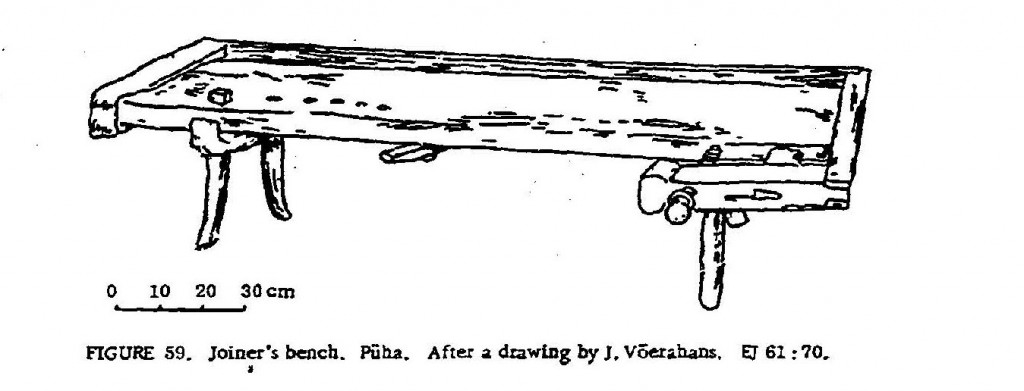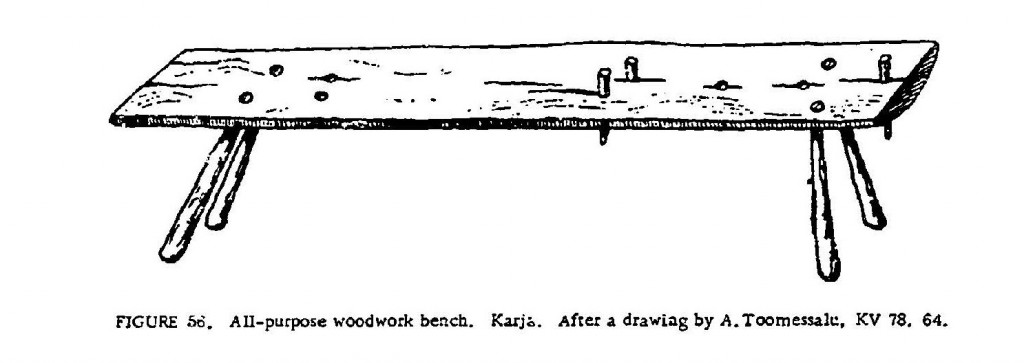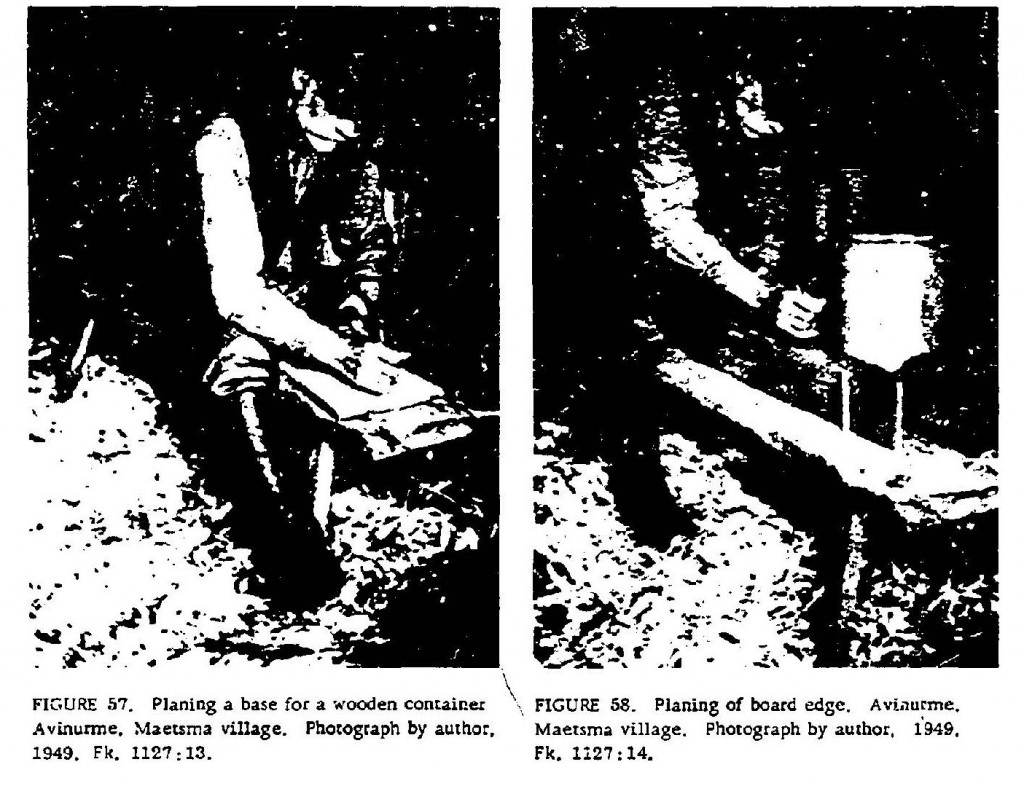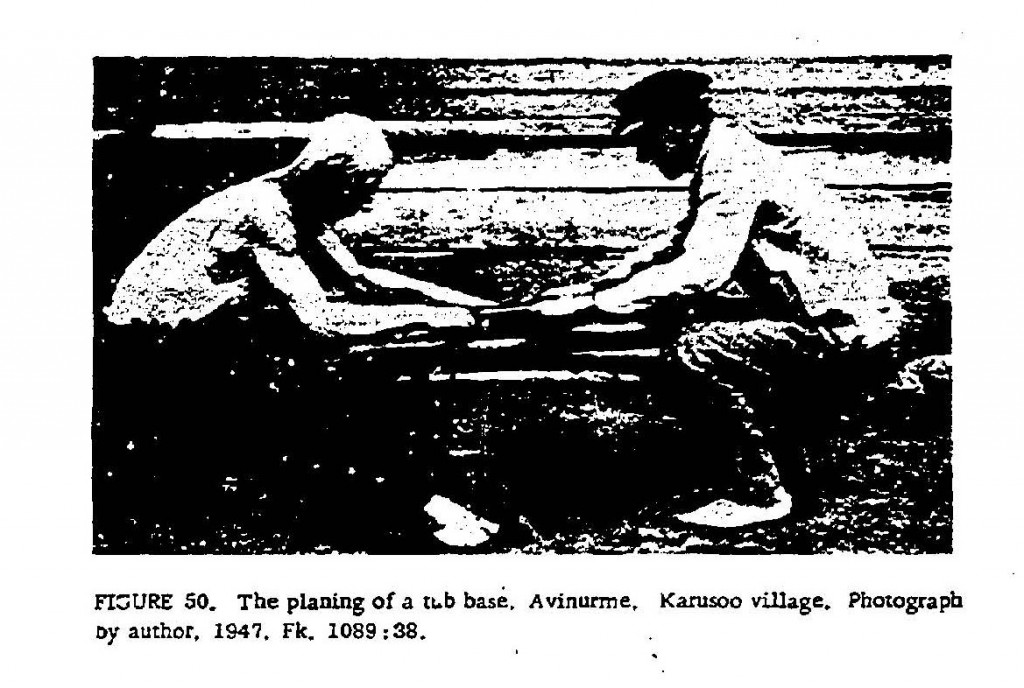We may receive a commission when you use our affiliate links. However, this does not impact our recommendations.
Roman workbenches have not left this world. In fact, some people might argue that they are still used today and are called shaving horses.
While I don’t have a dog in that particular fight, I do have some evidence to present on how they were used up through the 20th century in their original form: a thin plank with narrow legs tenoned into the plank.
The real story comes from a landmark book in hand-tool woodworking by A. Viires called “Woodworking in Estonia: Historical Survey” 1969. It’s a wonderful book with a strange history. It was copyrighted by the Israel Program for Scientific Translations Ltd. For the Smithsonian. While that all sounds nice and academic, it’s not.
While I still don’t have the full details on the history of the book, it appears it was translated and illegally published in the United States in 1969. Viires, the author of the Estonian book, says he had nothing to do with the translation. It was poorly done and was done against his will and wishes.
The book looks totally different in the original Estonian (I have a copy), but as I am still in Germany, I don’t have access to that copy. So I’ll have to use the Smithsonian version to talk about the Estonian-Roman woodworking connection.
Viires’ work, whether it was conscripted by foreign governments or not, is a remarkable glimpse into the pre-Industrial works in Estonia in the 20th century. It was a corner of the world where traditional skills and tools were still in daily use.
Of particular interest to me, of course, are the workbenches. These are low things that look unchanged since the Pompeii workbench shown in this blog entry.
Lots of people questioned whether the depictions of those benches is accurate. Are they really that low? That simple? With spindly legs?
I think the answer is “yes.” But I am happy to share some of the data I’ve collected during the last 10 years on the topic.
Here is an excerpt from Viires’ translated text that discusses the benches, how they were used and where they came from.
Use of the plane is connected with the use of a base upon which is to secure the object to be planed. For a long time a simple low bench, which was also used for all sorts of other woodwork, was used for that purpose. In some places this bench is to be found to this day (e.g., Avinurme), especially where woodwork as a home industry remains popular. The old bench, as we can see from models extant in Avinurme, has two holes at one end where the plank to be worked is secured against two inserted pegs. In doing so, the workman sits astride the bench, lending his weight to secure the board. In some benches only one peg is inserted. Long boards could be planed against the single peg with the planer sitting astride the board. There also used to be two holes in the middle of the bench, for use when the edges of the board were planed. Sometimes the bench had a square hole in the center for the inverted wedge when planing the side of a board.
Such simple benches were still in use among Russian home industry workers at the beginning of the present century. The urban cabinet maker also went on using them for a long time. Studying representations of Nurnburg cabinet makers from 1398 and 1444, it may be observed that identical benches were used. Only in German drawings of the 16th century do we see the appearance of higher and wider benches.
From Viires’ drawings and photos (sorry about the poor quality here), it’s clear that these benches were used for many tasks. And they weren’t braced against a wall or a post or anything else in particular. Instead, the stability, mass and pinching power came from a vise that is ultimately flexible and easy to acquire: the human body.
More details to come when I return home.
— Christopher Schwarz
If you like an historic approach to workbench design and construction, might I recommend the DVD “Build an 18th-century Workbench?” In it, I build a traditional French handtool workbench entirely by hand. With all the drawings, video and text you need to complete the project.
Here are some supplies and tools we find essential in our everyday work around the shop. We may receive a commission from sales referred by our links; however, we have carefully selected these products for their usefulness and quality.













Chris — I just returned from two+ weeks in Estonia. I found originals of this type of bench in both the Open Air Museum in Tallinn, and the National Museum in Tartu. Both were probably dated prior to 1900. In both cases, the staff was unsure of the items purpose, and were thrilled to get insight. I was able to take some pics in Tartu, but have to rummage them out.
Did not find a copy of the book in Estonian. Darn.
The benche are something. Notice the curved posts. Suggest that these are not bent but rived out of the tree’s butt swell .I made a stool hat way. Waste not, want not. The curved posts are natutral curves. They increase the foot print of the bench. We see such posts for tables and trestles. in Medival illustration. Woodworking in Estonia is a treasure. A good project for Lost Art. I have the “English” copy. Ugh. Can we find the plates or clean copy of original volume to print the pictures. Noticd that much of the text deals with woodworking in th huge island off of Estonia. Islands like that are often time machines. So was the end of Long Islnd and Appalachia. Could you suggest to WordPress that they add spell check for Comments. I suggest that the heavy workbench possibly may be waist height. It appears to be be too broad to sit across. It is great for boring bent over the bench and using. a spoon it Chairmaker hav used low benches fo centuries. See Make a Chair From a Tree p,54 for a crude but very workable example. You can easily make a post ane rung stool or strait back one slat chair with just a low benck and no shaving horse or lathe!. I have. The bencb screw on the larger work bench is Moxon’s single bench screw. NNUTS. (Nothing new under the Sun.) It is also used in modern Scandanavian benches. Did you know that Estonian and Hungarian share a language that is based upon non Indo-European roots. I met two wonderful ladies in a quilt group one from Estonie the other from distant Hungary ( it is quite a long walk!) . They could basically understand each other each speaking in their native tounges. How did that ever come to pass? Spooky. NNUTS. I made their quilting frame.
Jennie
Low benches are also good for shaping chair parts. It has been popular in Scandanavia down to the present. I gotta go, but you have lit me up. Thank you.
You’re right Dean. In an age where the transport of wood to a workshop would be difficult, the ability to bring the workbench to the wood would present many advantages.
In this Swedish video you can see someone working on a bench like that, chopping a mortice while sitting on the work. Around 9:20.
http://www.youtube.com/watch?v=wGDkliy1DEU
I often sit on the work too when doing chiselwork, Much faster then clamping and somehow also easier on my body.
It looks to me not unlike a sawbench.
In your article “The First Recorded Workbench”, my first thought was a “workbench” for use at the job site. That is, primarily for portability from shop to field (outdoors or indoors). The pictures seem to indicate that it was used only in the shop, which may be the case, but to me it still has that sense of portability.